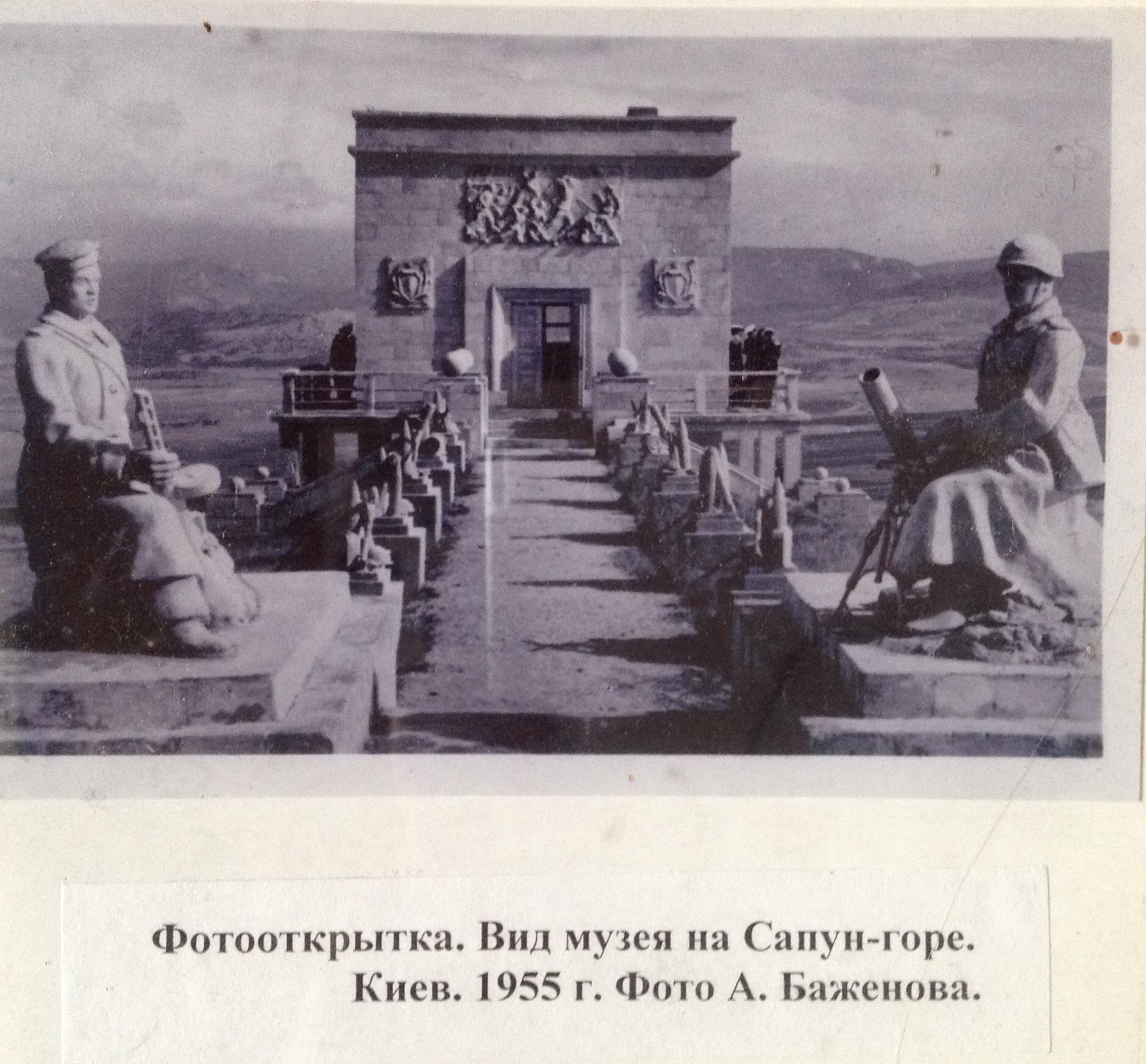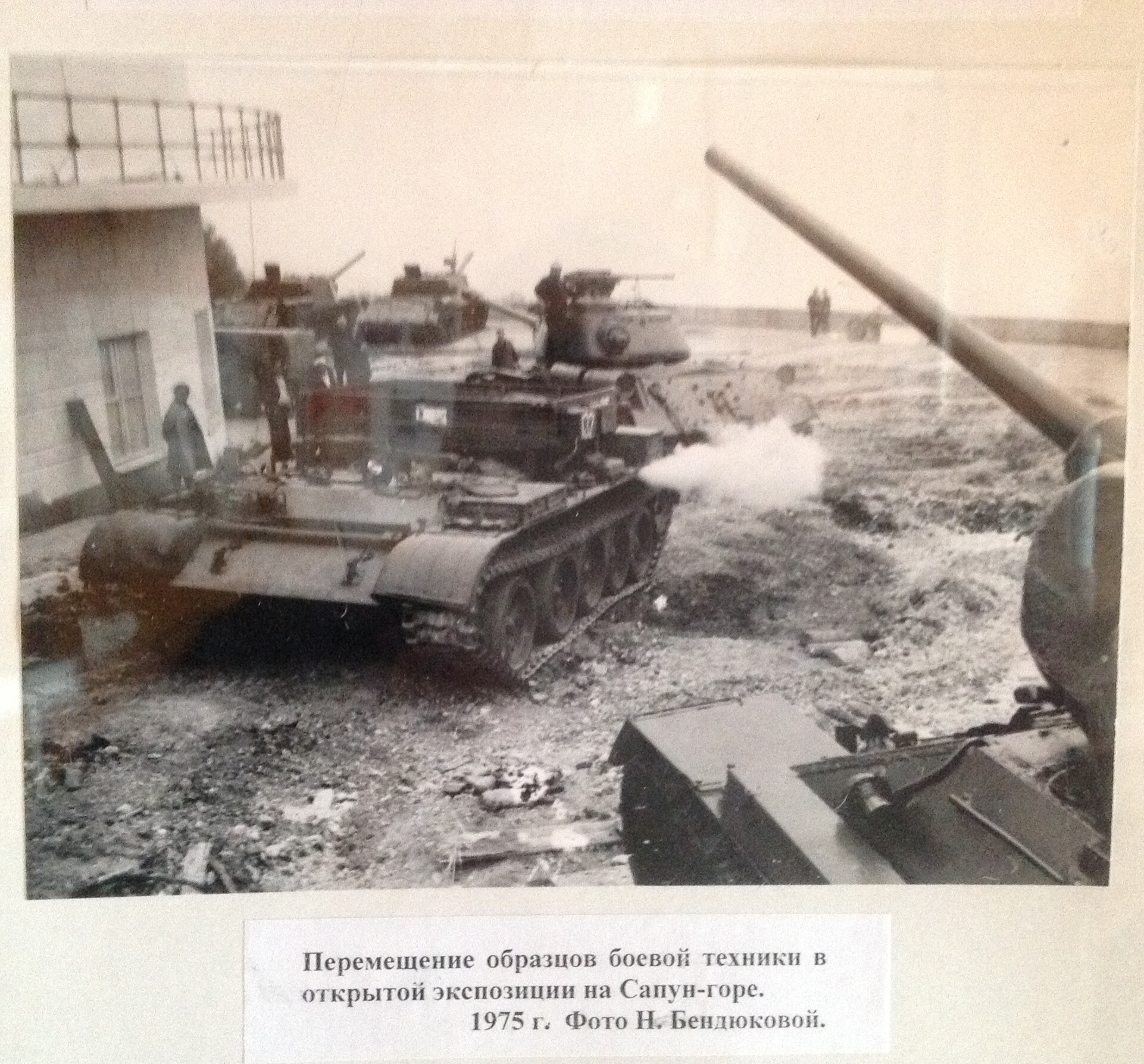The museum complex of WW2 (the Great Patriotic War 1941-1945) is situated on Sapun Hill. Upon arrival you will walk to the observation platform located in the area from which Commander-in-Chief of the British Army, Lord Raglan, watched the vainglorious disaster unfold before him during the Balaclava Battle of Crimean War on the 25th of October, 1854. Known as the Charge of Light Brigade, immortalised by Tennison, it can be clearly imagined and understood from the observation platform on the ridge.
The Diorama museum containing diorama itself and an exposition devoted to 250-days heroic defence and liberation of Sevastopol. The canvas (25-meter long and 5 meter in height) reflected one of the episodes of the battle for the liberation of Sevastopol from fascist troops, which took place on the slopes of Sapun Hill. The battle was led literally for every meter of Sevastopol land. The Diorama`s object plan has 83 sq.m.
Besides the building of Diorama, the Museum complex includes an open air exposition. It is possible to see models of Soviet weapons and equipment: tanks (include legendary T-34, self-propelled guns, cannons, first in the world rocket-artillery system "Katyusha" ("Stalin`s Organ" as Geramns said), bombs, automobiles, shells, artillery, military naval armaments, and also models of captured German weapons. The Eternal flame at the Monument of Glory with memorial complex are behind the building of Diorama.
Not far from is a Chapel of St. George, was built in 1995 in honor of 50-year anniversary of the Victory of the Soviet Union over fascists Germany.
The assault of Sapun-mount is one of the brightest episodes of the past war. Today here on the summit of Sapun-mount there is the memorial complex. The first monuments of the soldiers who attacked the enemy's defensive works, were erected straight after the liberation of Sevastopol in 1944. A broad path that was built through the Park of Glory leads to the monument of Glory. It was erected in 1944 and reconstructed in 1962 - 1964. On the monuments girdling the area, the names of formations of the Army and the Navy which took part in the liberation of the city, were carved. Near the monument there is the Eternal Fire which was kindled in 1970 in the day of 25th anniversary of the Victory.
A bit lower on the slopes of the mountain there is a monument to the fighters of the 77th division, all of them perished while the assaulting the defensive works of the enemy. The division was formed in Azerbaijan.
From the summit of Sapun-mount one can enjoy the spacial panorama of Zolotaya Balka, neighbouring mountains and hills where in 1941 - 1942 the defensive line was built. The soviet troops started their attack there in 1944, it ended up with the complete liberation of Sevastopol.

On 22 June 1941 World War II sprea its black wing over Ukraine and the Crimea. This war added many heroic, tragic and grim pages to the history of the Crimea. Sevastopol was among the cities to have received the first enemy's attack. It was at the cost of huge sacrifices and human lives that the city had to be defended...
To seize the Crimea, the 11th army, one of the best in the German armed forces, headed by general Mannstein, was chosen by Hitler. Its aviation made attempts to paralyze the Black Sea Fleet by attacking the naval bases and warships from the air. Anti-aircraft guns of Sevastopol joined the first battles against the bombers. To trap the vessels of the Black Sea Fleet int its main base, the fascists dropped ground magnetic mines weighing as much as almost one ton, in the bays of the city. The mines went down to the bottom to set off only when a boat or a warship were passing nearby. To destroy mines lying on the bottom, the Black Sea headquarters took a decision to have depth-bombs dropped in the areas of their location. Despite the risks of being blown up, the boats of the fleet fulfilled the task Under the pressure of the prevailing enemy's forces, the 51st army, which had been defending the Crimea on the Perekop Isthmus during three weeks, was compelled to retreat to Ishun positions.
The Coastal Army was put into action to help it, but it had to fall back too. Many soldiers and officers fought heroically - but the enemy was, unfortunately, far out-numbering in tanks, artillery and, especially, in aviation. On 29 October 1941 a state of siege was declared in Sevastopol. The Black Sea Fleet Commanders were taking urgent measures to repulse the enemy. The sailors and local population started constructing defence border-lines - trenches, pillboxes, tank ditches, wire and mine entanglements. The main defence borderline was mere 5 - 8 kilometers off the city.
One of the borderlines in the vicinity of village Duvankoy (now Verkhnesadovoye) was defended on 7 November 1941 only by 5 soldiers. They repelled the attack of seven and then 15 tanks more, of infantry, but all of them perished, having given their lives to the defence of their homeland. Their names are engraved on the granite slabs on the memorial wall in the centre of Sevastopol. That memorial also bears names of 54 Heroes of the Soviet Union awarded this high title for courage displayed in the defence of Sevastopol.
250 days and nights lasted the siege of the Black Sea stronghold. This second siege of Sevastopol entered the history of the Second World War. Having failed to seize Sevastopol straight away, on 13 November 1941 the fascists undertook the first storm of the city supported by aviation and with the use of 100 tanks, to be followed on 17 December by the second storm. The Soviet army was waging most fierce bloody battles repelling the enemy attacks. All the citizens stood up to defend the city.
The city's defence committee was set up, almost 15,000 citizens joined the Home Guard regiments, and fighting battalions and guerilla groups were established.
The 1942 spring enemy's offensive was defeated, but the forces were not equal. In the besieged Sevastopol people were dying from hunger and thirst, no medical care could be provided, bombardments demolished the city and took a heavy toll on it. On 4 July, 1942 the Soviet troops abandoned Sevastopol, but fighting against the enemy went on in the guerilla groups and in the underground organizations which provided the Big Land with valuable military intelligence, organized acts of sabotage in the rear of the enemy.
In the spring of 1944 the Soviet Army forces started acting on the offensive in the Crimea and the battle-front was rapidly approaching Sevastopol. The 4th Ukrainian front troops led by general F.Tolbukhin and the Black Sea warships and aviation were liberating the city.
On 7 May, 1944 started a legendary assault of Mt Sapun. The Hitlerites' fortifications were smashed and by the evening the enemy's defence-line was broken. Precisely one year before the Great Victory Day - on 9 May 1944 - Sevastopol was liberated and three days after the whole Crimea became free.

The city devastation was enormous, just a few buildings in its central part remaining intact. Neither electricity, nor water available. Factories, schools, hospitals, monuments have turned into ruins. Off started the revival of the white-stone city. Every day its railway station welcomed trains with new groups of builders. Every day brought along some changes for the better: the city was rising from the ashes and ruins.
For all of us this city has always been a symbol of courage. To commemorate the centennial anniversary of the first 1854-1855 defence, Sevastopol was awarded the Red Banner Order.
Giving honour to the military valour, fortitude, courage of its citizens, Sevastopol was awarded the highest title - that of the City-Hero - and the Gold Star Medal.
By its bright more than two hundred-years old history, two heroic defences the city has justified with honour its proud name, having become a symbol of fortitude and courage, military valour and unparalleled heroism.
Strict and solemn, business-like and festive is Sevastopol today, a city of unique fate and unexampled history. On the shores of 25 bays and over 11 hills stretches modern beautiful Sevastopol, washed by the Black Sea, buried in the verdure and caressed by the rays of the generous Crimean sun.

According to official documents:
Soviet Union lost 26 million 600 thousand people in World War II:
about 10,5-million of combat losses,
more than 16 million of civilians.
Ukraine lost about 8 million people in World War II (out of 26,6 million losses of all Soviet Union):
about 2 million of combat losses,
about 6 million civilians.
My grandfather was not a bad soldier - fascism fought not only communism, Stalin and the Red Army, but also fought my civil people!
We remember!
Website Administrator
| 